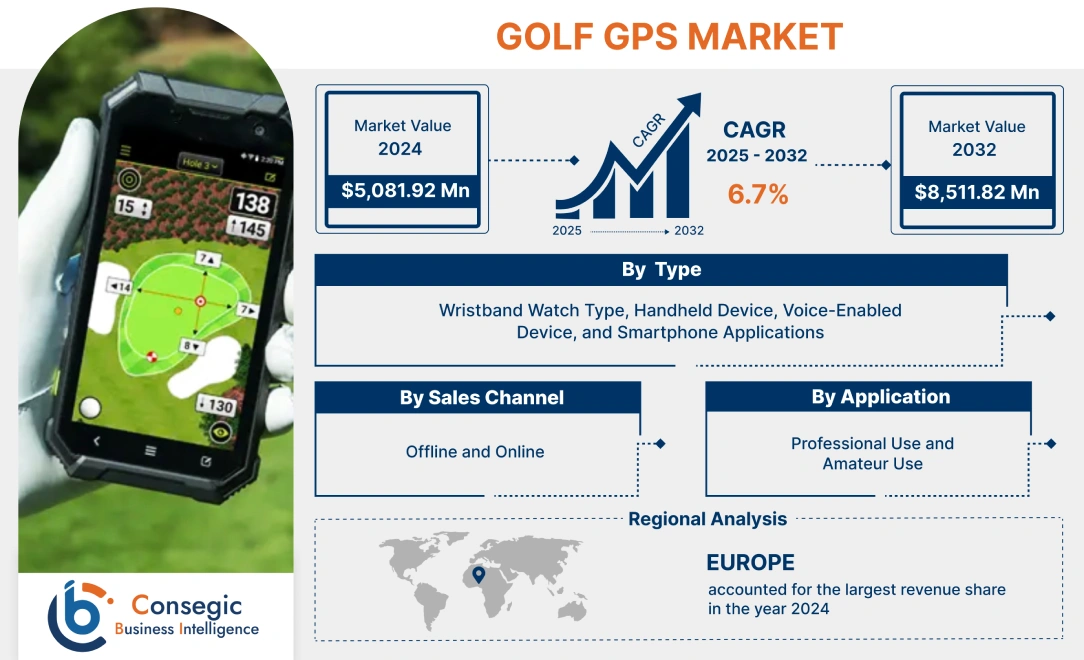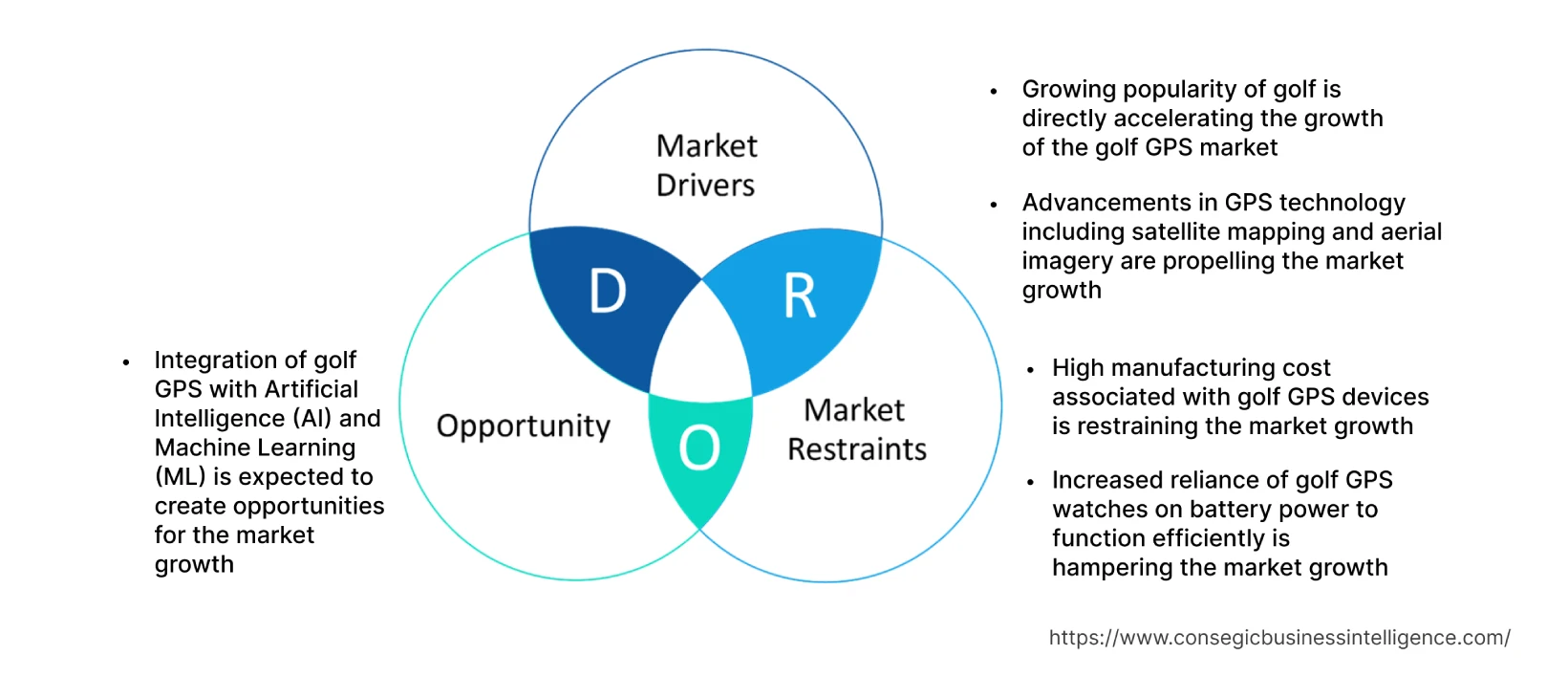Golf GPS Market Introduction :
Golf GPS Market Size is estimated to reach over USD 8,511.82 million by 2032 from a value of USD 5,081.92 in 2024, growing at a CAGR of 6.7% from 2025 to 2032.
Golf GPS Market Definition & Overview :
Golf GPS (Global Positioning System) refers to a technology used in golf sports to provide players with precise distance measurements on a golf course. It utilizes a network of satellites to determine the exact location of an object or individual on Earth. Additionally, these devices have preloaded course maps, allowing golfers to view information including the distance to the front, center, and back of greens, hazards, fairway bunkers, and other points of interest on the course.
Golf GPS Market Insights :
Golf GPS Market Dynamics - (DRO) :
Key Drivers :
Growing popularity of golf
The rising interest of individuals in golf as a recreational activity or competitive sport is increasing the demand for golf-related products and services including GPS devices enabled for golf. Golfers are continuously seeking ways to enhance the game and improve the performance on the course. These devices offer valuable information, namely precise yardages and course mapping that aid golfers in making better decisions and optimizing the shots. Additionally, these devices are designed to be user-friendly and accessible to golfers of all skill levels by providing precise information to navigate the course more effectively.
Assessment of market trends suggest that the growing interest of users in golf is contributing significantly in driving the expansion of the market to determine the exact location of an object. For instance, in January 2022, according to the National Golf Foundation (NGF), the participation of people in golf in 2021 increased by 600,000 accounting to 37.5 million. Additionally, the on-course golfers accounted for approximately 25% of women and 12% of youth, hence contributing notably in increase of Golf GPS market demand.
Advancements in GPS technology like satellite mapping and aerial imagery
GPS allows for accurate positioning and tracking of golfers on the course, enabling precise distance measurements and course mapping. The increased availability and accuracy of GPS technology is significantly enhancing the functionality and reliability of these devices. Additionally, advanced satellite mapping and aerial imagery technologies are revolutionizing the way golf courses are mapped and visualized. These devices provide detailed and high-resolution course maps, incorporating accurate representations of hazards, greens, fairways, and other key course features. The technologies offer golfers a comprehensive view of the course to hit the shot in an accurate direction, thus contributing significantly in spurring the Golf GPS market demand.
Furthermore, the integration of GPS technological functionalities into wearable devices namely golf watches and smartwatches are also boosting the market growth. Wearable devices provide golfers with real-time distance measurements and other golf-related data conveniently on the wearable wrist device, thus eliminating the need for handheld devices. For instance, in March 2021, Garmin International Inc. launched the Approach S6 touchscreen watch to improve the golfer's swing consistency and synchronization. The advanced watch encompasses a high-resolution touchscreen display along with color CourseView maps to show the precise distance to any point on the hole.
Key Restraint :
High manufacturing costs associated with GPS devices
The cost of production of golf GPS devices is relatively high owing to the incorporation of advanced features and technologies. The integration of advanced technologies including aerial imagery and satellite mapping increases the upfront cost, thus restraining the proliferation of the market. The high manufacturing cost of these devices acts as a barrier, particularly for casual and occasional players, unwilling to invest in them. The high manufacturing cost limits the adoption of GPS enabled golf devices by occasional players, hence impeding the development of the global market.
Increased reliance of golf GPS watches on battery power to function.
Future Opportunities :
Integration of golf GPS with Artificial Intelligence (AI) and Machine Learning (ML).
AI and ML algorithms analyze a golfer's historical data, performance patterns, and course information to provide personalized recommendations. The integration considers factors including playing style, strengths, weaknesses, and environmental conditions, to offer tailored strategies for improving performance. In addition, AI and ML analyze large datasets generated by golf GPS devices, including shot data, course conditions, and golfer statistics. The technologies provide comprehensive performance analysis, identifying trends, patterns, and areas for improvement. Golfers gain valuable insights into the gameplay, identify areas of focus, and make data-driven decisions to enhance performance. Consequently, the personalized approach enhances the user experience, helps golfers to optimize the gameplay, thus emerging as a Golf GPS market opportunity for growth.
Golf GPS Market Report Insights :
| Report Attributes | Report Details |
| Study Timeline | 2019-2032 |
| Market Size in 2032 | USD 8,511.82 Million |
| CAGR (2025-2032) | 6.7% |
| Based on the Type | Wristband Watch Type, Handheld Device, Voice-Enabled Device, and Smartphone Applications |
| Based on the Sales Channel | Offline and Online |
| Based on the Application | Professional Use and Amateur Use |
| Based on the Region | North America, Europe, Asia-Pacific, Latin America, and Middle East & Africa |
| Key Players | Amazfit (Zepp Health Corporation, Ltd.), Bushnell Corporation, Celestron LLC, Garmin International, Inc., GolfzonDeca Inc., Izzo Golf, Inc., Samsung Electronics Co. Ltd., SkyHawke Technologies, TomTom N.V., Topgolf Callaway Brands Corp. |
Golf GPS Market Segmental Analysis :
Based on the Type :
The type segment is classified into wristband watch type, handheld device, Voice-Enabled Device, and smartphone applications. The largest Golf GPS market share was accounted to the Handheld devices segment in 2024 as the devices have larger screens, allowing for more detailed course mapping and better visibility. The larger display allows for better navigation, shot planning, and overall course management. Additionally, several handheld devices offer color displays, enhancing the visual experience and usability of the user. The Golf GPS market analysis indicated that handheld devices also tend to provide advanced features including touchscreens, shot tracking, club recommendations, and comprehensive analytics, further driving the expansion of the market. For instance, in May 2021, Bushnell Corporation launched Phantom 2, a handheld device with a larger display than the previous generation. The transflective display offers high visibility even in bright sunlight, thus contributing remarkably in accelerating the Golf GPS market growth.
The wristband watch type segment is anticipated to witness the fastest CAGR in the market during the forecast period. The proliferation is attributed to the increasing adoption of wearable devices including smartwatches and fitness trackers across various industries, including sports and fitness. Additionally, wristband GPS watches offer a high level of convenience and portability to users by eliminating the need to carry a separate device. Golfers easily access GPS data, distance measurements, and other golf-related information with a quick glance at the wrist, further driving the development of the market. Moreover, analysis of market trends indicates that manufacturers are introducing advanced features including color displays, touchscreens, and intuitive interfaces to enhance the user experience. Furthermore, the watches also offer water resistance, durability, and fitness tracking capabilities, thus contributing considerably in propelling the growth of the wristband watch type device system.
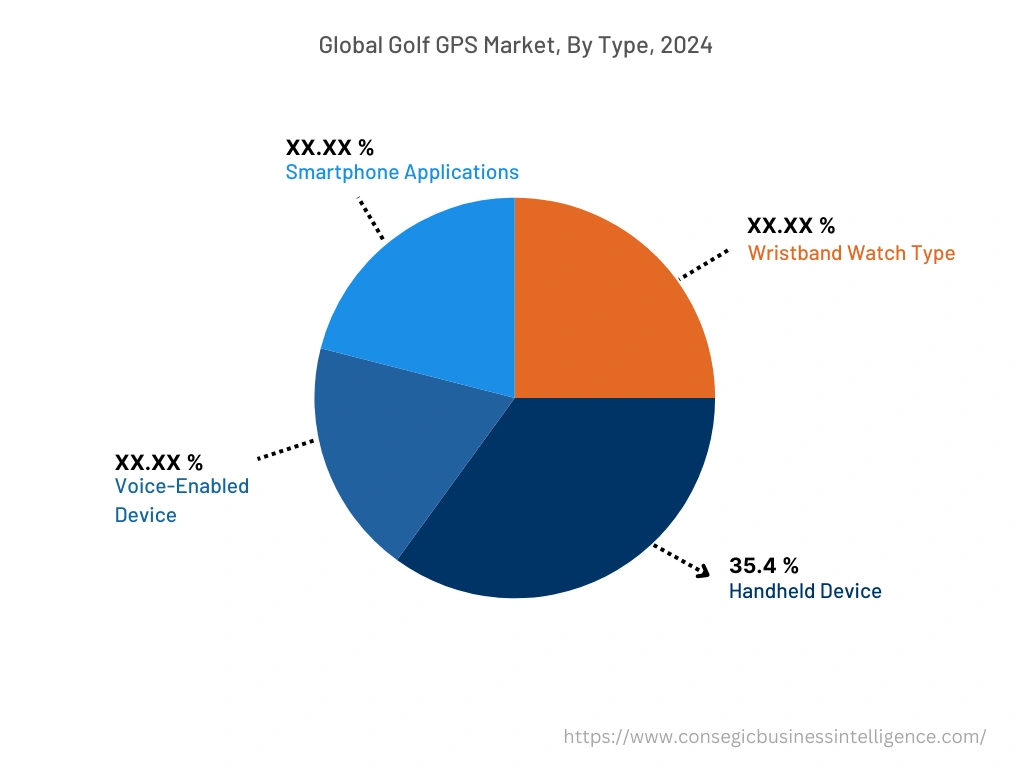
Based on the Sales Channel :
The sales channel is bifurcated into offline and online. The largest Golf GPS market share was accounted to the Offline sales channel segment in 2024 as offline sales channel allow customers to physically interact with the devices, test the features, and enquire questions to sales representatives. Additionally, physical stores provide assistance to customers on various factors associated with accuracy, course coverage, ease of use, features, battery life, and price of the devices. Golf GPS market analysis suggested that offline sales channels provide various opportunities for customers to have detailed conversations with sales representatives to receive expert advice and guidance for the specific GPS devices. Evaluation of market trends suggest that personalized interaction helps customers to make better decisions and contributes significantly in the purchase of the product, thus accelerating the Golf GPS market growth.
Online sales channel is predicted to witness the fastest CAGR in the market during the forecast period. The growth is credited to the increasing popularity of e-commerce platforms that offer consumers opportunities to shop online. Additionally, the online sales channel also offers a wide range of products, easy price comparisons, and doorstep delivery, further driving the growth of the segment. Moreover, online channels also provide a vast array of devices from different brands and models enabling customers to explore multiple options, read reviews, and compare features and prices. Furthermore, online platforms frequently offer discounts, promotional deals, and exclusive offers to attract customers, thus contributing remarkably in accelerating the market proliferation.
Based on the Application :
The application segment is classified into professional use and amateur use. Professional users accounted for the largest market share in 2024 owing to the increasing adoption of GPS devices to analyze course layouts, distances, and potential hazards. The professional golfers perform analysis on the course maps, identify the best routes, and develop strategic plans for each hole. These devices help professionals to make informed decisions on club selection, shot placement, and course management to optimize performance. Additionally, market trends suggest that professional golfers rely on accurate yardage measurements to plan their shots with precision. They also provide precise distance information to the front, back, and center of the greens, as well as distances to hazards, bunkers, and other key landmarks on the course. Consequently, the increasing number of professional golfers is contributing notably in fueling the advancement of golf relating GPS services to assess shot distances more accurately and precisely. For instance, according to the Golf Australia report, the participation of professional golfers increased by 21% in 2020 with an estimated additional 210,000 individual playing the game. Additionally, male participation increased to 9.3% in the 2021 games held in Australia, which in turn, raises the demand for advanced golf GPS systems.
Amateur golfer segment is anticipated to witness the fastest CAGR in the market during the forecast period. Amateur golfers utilize GPS devices to determine distances to hazards, fairways, greens, and other points of interest. The information helps amateur golfers to draw informed decisions on club selection and shot strategy, improving accuracy and overall performance. In addition, GPS devices offer detailed course maps to help amateur golfers navigate the course more effectively. The maps display hole layouts, including the location of hazards, bunkers, and doglegs. Recent market trends indicate that amateur golfers utilize the GPS device to plan the shots, avoid obstacles, and strategically position themselves for optimal play. The course mapping feature provides valuable guidance to golfers, unfamiliar with the course layout, thus contributing considerably in driving the market proliferation during the forecast period.
Based on the Region :
The regional segment includes North America, Europe, Asia Pacific, Middle East and Africa, and Latin America.
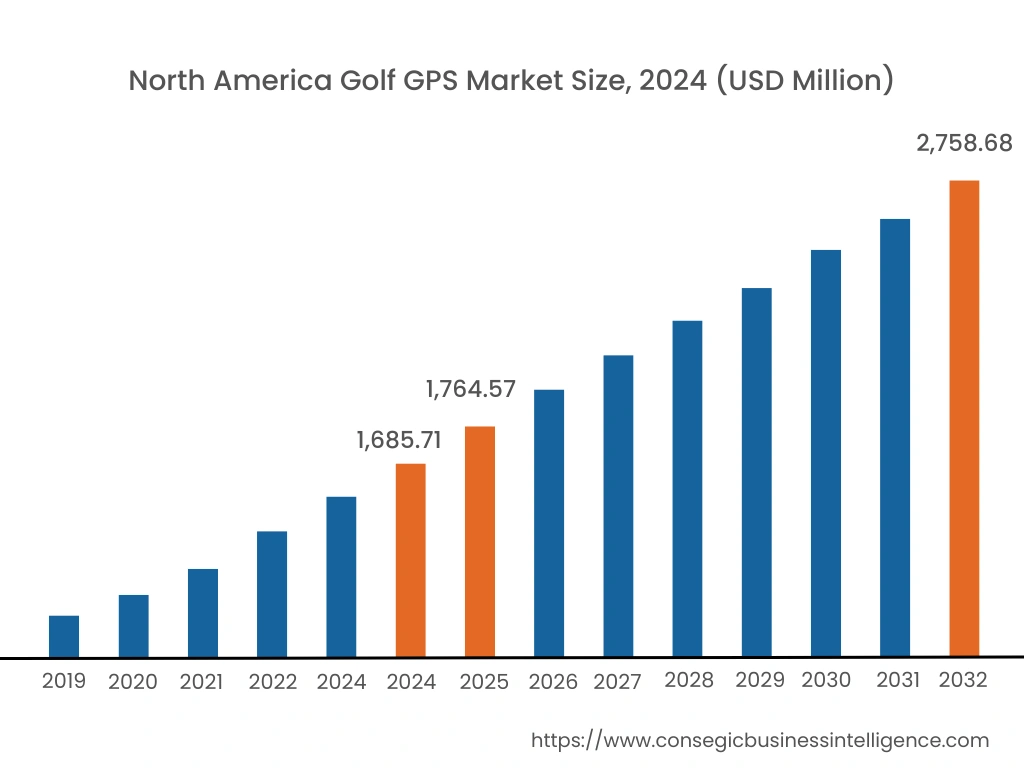
Europe accounted for the largest revenue share in the year 2024 as the region has a rich golfing tradition, with a long history of golf courses and a large number of avid golfers. Golf is a popular sport and recreational activity in many European countries, and the strong golfing culture has contributed to the demand for GPS devices. Additionally, Europe is known for technological advancements and innovation across various industries, including sports. Analysis of Golf GPS market trends concludes that the European manufacturing industry and developers are at the forefront of designing and producing high-quality GPS devices. The region's emphasis on research and development, coupled with the presence of key players, has resulted in innovative features and advanced functionality in GPS devices, attracting both European and global consumers. Consequently, advancements in technology and the rich golfing tradition is encouraging a large number of Europeans to play golf, which in turn, promotes the development of the market. For instance, according to the European Golf Participation Report of 2021, the total number of golfers participated in European golf across Europe was 10,617,000 and the market grew by 73% in terms of registered golfers between 2019 and 2021.
North America accounted to USD 1,685.71 in 2024 and is expected to register the fastest CAGR of 6.40% accounting to USD 2,758.68 Million in 2032 in the market. In addition, in the region, the United States accounted for the maximum revenue share of 51.56% in the year 2024. The proliferation in the region is attributed to the advancements in technology including satellite mapping and aerial imagery that enhances the functionality and reliability of golf GPS devices. Analysis of Golf GPS market trends showcases that the region's emphasis on research and development, coupled with technologically advanced population, allows for the continuous improvement and adoption of new technologies in the market. Moreover, North America has a well-established distribution network for golf-related products. Major retailers, golf specialty stores, and online platforms offer convenience to consumers to access and purchase GPS devices. The accessibility and availability of GPS devices through robust distribution channels, thus contribute significantly in accelerating the market expansion in North America.
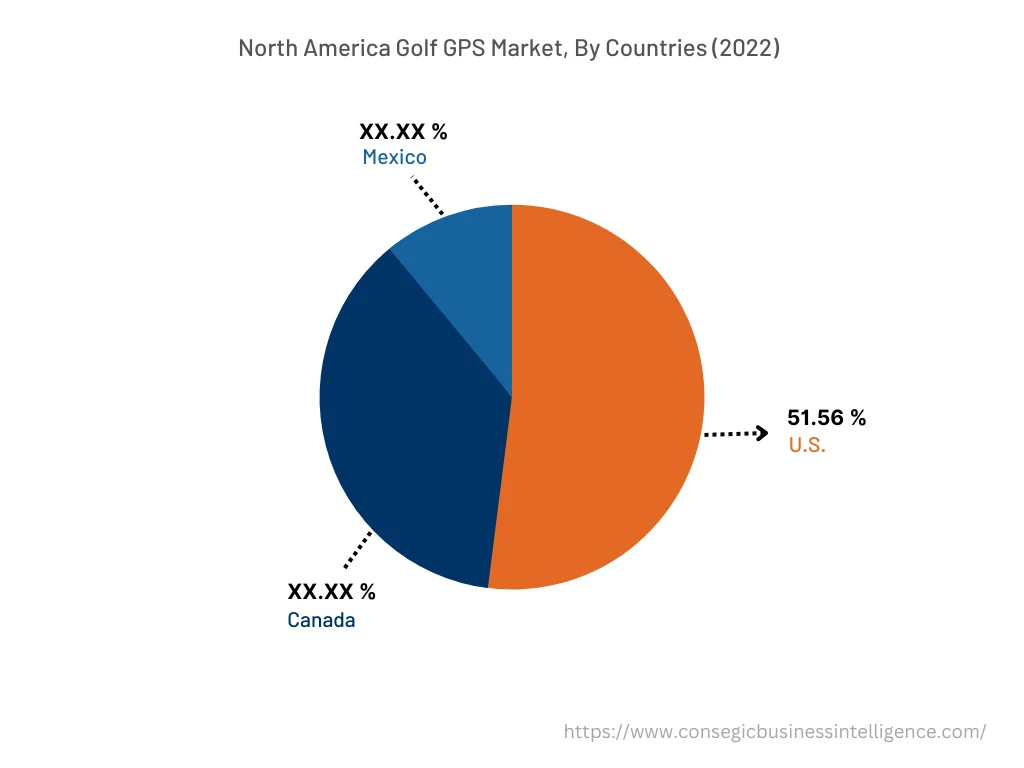
Top Key Players & Market Share Insights :
The competitive landscape of the Global Golf GPS market has been analyzed in the report, along with the detailed profiles of the major players operating in the industry. Further, companies functioning in Golf GPS industry engage in Research and Development (R&D), product innovation, various business strategies, and application launches thus accelerating the development of the market. Key players in the market include-
- Amazfit (Zepp Health Corporation, Ltd.)
- Bushnell Corporation
- SkyHawke Technologies
- TomTom N.V.
- Topgolf Callaway Brands Corp.
- Celestron LLC
- Garmin International, Inc.
- GolfzonDeca Inc.
- Izzo Golf, Inc.
- Samsung Electronics Co. Ltd.
Recent Industry Developments :
- In January 2023, Samsung Electronics Co., Ltd. launched the Galaxy Watch5 golf edition and Galaxy Watch5 Pro golf edition to deliver data-driven insights to golfers. The smartwatch is designed with a titanium design to offer improved durability and a free lifetime subscription to users.
- In January 2023, Amazfit launched Amazfit Falcon, a premium multi-sport GPS watch with a smart coaching algorithm that provides tailored guidance to the user to improve the sports performance. The watch is manufactured using a sapphire crystal glass screen, features accurate GPS tracking and 20 ATM water-resistance capabilities.
Key Questions Answered in the Report
What is Golf GPS? +
Golf GPS (Global Positioning System) refers to a technology used in golf to provide players with precise distance measurements on a golf course. Golf GPS utilizes a network of satellites to determine the exact location of an object or individual on Earth.
What specific segmentation details are covered in the Golf GPS market report, and how is the dominating segment impacting the market growth? +
The handheld devices dominate the market share as the devices have larger screens, allowing for more detailed course mapping and better visibility. The larger display allows for better navigation, shot planning, and overall course management, driving the growth of the market.
What specific segmentation details are covered in the Golf GPS market report, and how is the fastest segment anticipated to impact the market growth? +
The amateur golfers are anticipated to witness the fastest CAGR as amateurs utilize GPS devices to determine distances to hazards, fairways, greens, and other points of interest. The information helps amateur golfers to make informed decisions on club selection and shot strategy, improving accuracy and overall performance.
Which region is anticipated to witness the highest CAGR during the forecast period, 2025-2032? +
North America is expected to witness the fastest CAGR during the forecast period owing to the advancements in technology including satellite mapping and aerial imagery that enhances the functionality and reliability of golf GPS devices.
